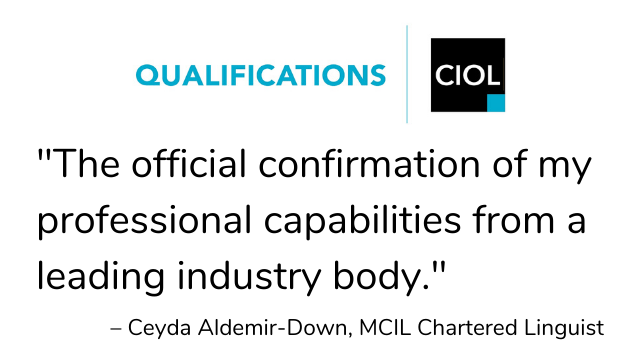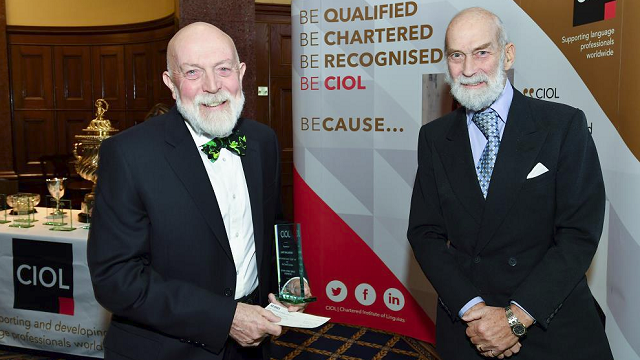-
QUALIFICATIONS
- For Linguists Worldwide
- For UK Public Services
- Preparation
- Policies & Regulation
-
MEMBERSHIP
- Join CIOL
- Membership grades
- NEW for Language Lovers
- Chartered Linguist
- Already a member?
- Professional conduct
- Business & Corporate Partners
-
ASSESSMENTS
- For Second Language Speakers
- English as a Second Language
-
EVENTS & TRAINING
- CPD, Webinars & Training
- CIOL Conference Season 2025
- Events & Networks
- CIOL Mentoring
-
NEWS & VOICES
- News & Voices
- CIOL eNews
- CIOL Awards
- The Linguist
- Jobs & Ads
-
RESOURCES
- For Translators & Interpreters
- For Universities & Students
- Standards & Norms
- CIOL & AI
- All Party Parliamentary Group
- In the UK
- UK Public Services
- Find-a-Linguist
The power of bilingualism
by Hero Cai FCIL, CL, MITI
 It is commonly acknowledged that being a translator or interpreter requires bilingualism (or multilingualism). But is it the same case with teaching English to speakers of other languages? We seem to be less certain when there is a native English speaker who does not speak the mother tongue of his/her students and a local teacher whose native language is not English.
It is commonly acknowledged that being a translator or interpreter requires bilingualism (or multilingualism). But is it the same case with teaching English to speakers of other languages? We seem to be less certain when there is a native English speaker who does not speak the mother tongue of his/her students and a local teacher whose native language is not English.
I was born to speak Mandarin Chinese as my native language, not English. That is a fact that I can never change. Back in around 2005, when I wanted to start my career as a local teacher of English, I was asked by my interviewer, ‘Why do you think we should hire you instead of a native English speaker who is equally passionate about English education?’ I was not really prepared for this question and the only answer that came to my mind at that time was that I was able to use Chinese when my students could not understand a lecture given in English. Now, having worked as an interviewer for quite a few years myself, I would probably consider it one of the poorest answers from a candidate for a teaching position. It is because by giving that answer, I seemed to be summarizing my professional competitiveness as being able to speak the mother tongue as fluently as everybody else in my country. So, I was totally surprised (and a bit amused) when several days later I received a call from the interviewer, telling me I had passed the interview and was expected to report to work the next day.
So I did. The school I worked for was one of China’s biggest English training institutions and was later listed in NASDAQ. During the four years working as a local teacher, I went to great lengths to hone my language and teaching skills, hoping that my supervisor, who was the same person as the interviewer, would not regret making the decision to recruit a local teacher who was proud of being able to speak his mother tongue that day. For those efforts, I was awarded ‘Group Outstanding Teacher’, which was the highest-level certification for front-line teachers nationwide within the group. However, I still could not find the answer to the question I was asked in the interview. Does being bilingual really help in teaching English? If yes, how?
In linguistics, one’s mother tongue, which is referred to as ‘L1’, is traditionally considered an interference in acquiring a foreign language. Does it mean that Chinese, as is in my case, should be totally avoided to ensure an immersive English environment in the learning process? While it is true that language immersion plays a vital role in shaping the English way of thinking as well as developing proficiency, there are places in the world where exposure to English can hardly be greater than to L1. Taking myself as an example, I was born in Shanghai, which is widely recognized as one of the most ‘international’ cities in China’s mainland. However, the truth is I have never found the opportunity to practise using English to order meals at a restaurant after I learnt it in the textbook. It is not because no waiters or waitresses speak English in Shanghai; it just seems really odd to me when, in a real-life situation, two Chinese people should choose to communicate with each other in a foreign language over their mother tongue! So, the dilemma is that the English environment tends to be only available when the ‘learning mode’ is on and will immediately cease to exist as people shift to the ‘living mode’. In this case, shall we ask our students simply to stick to the learning mode all the time and forget about their normal lives? Or, shall we try to find a way to embrace both languages?
To better understand the connection between Chinese and English, I resigned from my teaching position and went to London to study conference interpreting. After graduation, I stayed in London and began my career as a conference interpreter. I also did some translation in my spare time. These experiences allowed me to examine more closely than ever before what Chinese and English are to each other. When doing interpreting or translation, it is not possible to ignore either language. On the contrary, interpreters and translators have to be keenly aware of the similarities and differences between the two languages and keep the conduits for both languages open at the same time. In this process, L1 is no longer an interference; it is one of the two legs.
After working in London for a few years, I grew even more confident that the two languages, instead of hindering each other, could actually be connected to support each other. So, I said to myself, ‘it’s time to return to China, my homeland, to use the power of bilingualism to help more people speak English.’ My decision came with the great news from the CIOL: I was accepted as a Member in the categories of interpreting, translation and teaching English. About a year after that, I was also accepted as a Member of the ITI in the category of conference interpreting. In 2018, I started my own business ‘Flipped English’ (翻转英语)to offer online English courses to Chinese students. One of the most important features of the course design is what I call ‘L1 Facilitation’, a concept as opposed to L1 Interference. At Flipped English, L1, contrary to being discouraged, is used throughout the courses as a way to enhance learning efficiency.
One example is the International Phonetic Alphabet course for Chinese adult learners. When the majority of IPA learners are beginners (including the absolute beginners), the traditional way of teaching - from the symbol of /æ/, to the sound of it, together with the often arcane illustration of the tongue and mouth, then to sample words such as ‘apple’ and ‘dad’ - can be rather intimidating and thus less efficient in my country. Due to the fact that the Chinese language does not look or sound similar to English at all, beginner-level learners tend to find it extremely difficult to understand what is being taught with the traditional approach and most of them would have to give up at an early stage of learning.
With the concept of L1 Facilitation, we don’t start with the strange symbol of /æ/ or go straight to the teaching of its pronunciation. As Step 1, we ask students to simply use their ears and listen to two sounds. They are told that one of the sounds is English and the other Chinese, and are asked to guess which is which after hearing them. What is read to students is the English sound of /æ/ and the Chinese sound of “爱”, the latter being a common mispronunciation of /æ/ among Chinese learners. As there is one sound that they are extremely familiar with, everyone is able to find out which one is the English sound instantly.
Then as Step 2, students are asked to describe the difference between the sounds they hear. Amazingly enough, nearly no one seems to have difficulty to tell that the English sound of /æ/, compared with the Chinese sound of “爱”, sounds sharper and stronger, and that it seems the mouth must be opened wider to pronounce the English sound. And they are right. In this way, students can find out how to pronounce the unfamiliar with the help of the familiar and understand perfectly how to avoid confusing the two sounds. In this teaching process, the teacher does not TELL students the techniques or rules of English pronunciation; the teacher just PAIRS up an English sound with a Chinese one and SHOWS them to students. And as students actively explore what they hear, the knowledge tends to be internalized much more efficiently.
The idea of turning the mother tongue to be a powerful tool of English learning has proved to be a success in the market as well. Since the first course was launched through Flipped English in 2018, it has received tremendous acclamation and support from the learners. By 10th July 2019, the registered student number reached over 200,000. Two months later, came even the greater news. The CIOL approved my application and awarded me the Fellowship! To me, it means the great honour to continue to take on the responsibility to‘promote and share the highest standards’ of the industry, quoting from CIOL’s Fellowship criteria.
As a linguist, I believe in not only the power of language, but also the power of bilingualism. There are reportedly more than 300 million people learning English in China alone. I look forward to the day when all learners know how to use their mother tongue not to interfere with, but to facilitate their English learning.
More
The Chartered Institute of Linguists (CIOL), Incorporated by Royal Charter, Registered in England and Wales Number RC 000808 and the IoL Educational Trust (IoLET), trading as CIOL Qualifications, Company limited by Guarantee, Registered in England and Wales Number 04297497 and Registered Charity Number 1090263. CIOL is a not-for-profit organisation.








